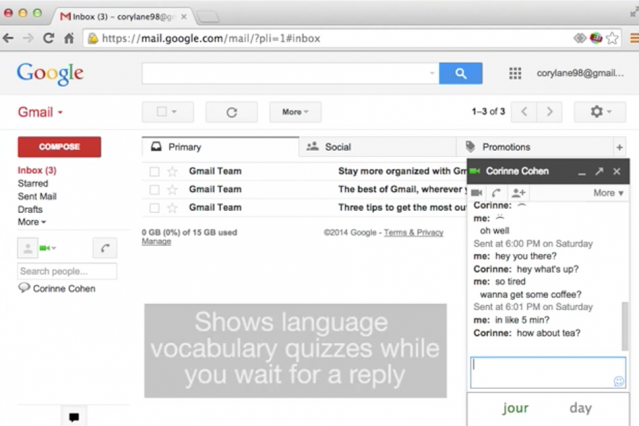"WaitChatter" app teaches vocabulary during moments in between texts

The average person spends 10 to 15 minutes a day waiting for texts and instant-message (IM) replies, according to an analysis by Carrie Cai, a PhD student at MIT's Computer Science and Artificial Intelligence Lab (CSAIL).
What if you could be more productive during those idle moments? Cai is on the case.
A CSAIL team led by Cai recently developed "WaitChatter," a Google Chat extension that delivers foreign-language vocab quizzes right to your chatbox any time the system detects that you are waiting for an instant message.
"Given all the time that is wasted due to waiting, we wanted to explore how to use these moments as opportunities for learning," says Cai, who presented a related paper at the Association of Computing Machinery's Computer Human Interaction Conference (CHI 2015) in Seoul in April. "This integrated approach, which we call 'wait-learning', is far less likely to be perceived as time-consuming or intrusive compared to using a separate learning app."
The team's paper is part of a growing field of "micro-learning" research that has developed over the last decade and spurred apps like Duolingo and the screen-saver Unlock Your Brain. But Cai thinks the future of the space may hinge on easy-to-embed apps that allow users to learn when they would otherwise be twiddling their thumbs.
"People who say they want to learn a language often try an app like Duolingo and end up feeling that they have to 'make time' or invest extra effort for it," she says. "Users generally don't want to have to close a window or switch apps, which means it's important to incorporate the learning tool right into the programs they use."
In a pilot study, WaitChatter users learned an average of about four words a day over a period of two weeks. The system takes words from both a built-in list as well as the user's ongoing chat conversations. For example, individuals discussing an upcoming Starbucks date will be quizzed on terms like "coffee" and "tea." These quizzes are scheduled dynamically so that words which the user has trouble with appear more frequently.
WaitChatter, which was developed in collaboration with MIT professors Rob Miller and Jim Glass, former CSAIL postdoc Philip Guo, and undergrad Anji Ren, was tested in French and Spanish, but can handle any alphabet-based language that's available on Google Translate. The team says that the underlying technology could also be applied to the code of other IM platforms, including Snapchat, Facebook, Skype and WhatsApp.
Cai concedes that wait-learning is not a particularly suitable method for becoming fluent in a language or learning complex concepts like linear algebra or quantum physics. However, she says that it can offer some real value for flashcard-style memorization of topics like chemical compounds or technical terminology.
In the future, CSAIL researchers plan to explore opportunities to create technologies for other wait-learning situations, such as Wi-Fi seeking, email loading, and even elevator waiting.
"There are a lot of busy people out there looking for 'life hacks' and productivity tricks," Cai says. "We've just scraped the surface for studying different ways we can help people make the most of these micro-moments."
More information: "Wait-Learning: Leveraging Wait Time for Second Language Education": people.csail.mit.edu/ccai/publ … WaitLearningFull.pdf
Provided by Massachusetts Institute of Technology
This story is republished courtesy of MIT News (web.mit.edu/newsoffice/), a popular site that covers news about MIT research, innovation and teaching.



















